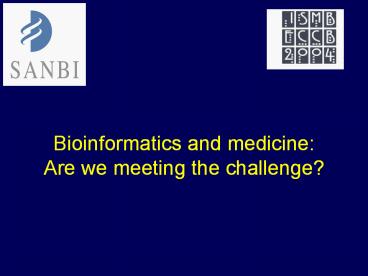Bioinformatics and medicine: Are we meeting the challenge? PowerPoint PPT Presentation
1 / 14
Title: Bioinformatics and medicine: Are we meeting the challenge?
1
Bioinformatics and medicineAre we meeting the
challenge?
2
Breadth of Submissions
- Submissions 24
- Major Categories of areas submitted
- Cancer / genomics
- Statistics/linkage analysis
- Immunolgy/modelling
- Image analysis
- Transcriptomics
- Classifiers
- Implementation of high throughput pipelines
3
Potential for applications
- Molecular Pathology
- Diagnosis and detection
- Molecular Medicine
- Complex inherited disorders
- Epigenetics and human disease
- Genomic Medicine
- Pathogens and vaccine development
- Cancer
4
Challenges
- The molecular biologist
- The high throughput biologist
- The systems biologist
- The clinician
- Biomedical informatics? Is that what we mean?
- Who is ensuring the application of bioinformatic
knowledge to medicine?
5
When will Bioinformatics activities substantially
affect the practice of medicine?
- Victor Maojo and Casimir A. Kulikowski
- - Medical informatics
- - clinical and bibliographic databases
- - computerised medical records
- - medical information systems
- Perception that medline is simply a data source
Bioinformatics and Medical Informatics
Collaborations on the Road to Genomic Medicine?
J Am Med Inform Assoc. 2003 November 10 (6)
515522
6
- potential synergies and competition between
medical informatics (MI) and bioinformatics (BI)
J Am Med Inform Assoc. 2003 November 10 (6)
515522
7
The two major knowledge domains
Anatomy Pathology Epidemiology Immunology
Biochemistry Metabolism Gene function,
expression Regulatory and interaction
networks Genetics
8
Growth and field convergence
- Analysis of gene and protein technologies
- Molecular Biology and biochemistry
- Data quality and analysis, noise and uncertainty
- Integration via curation
- Ontologies, network models
- Signal and image processing
- Widely available tools
- Education and training
- 1960s rapid launch on back of computer
technologies in health care - Medical standardisation
- Clinical data subjectivity create mining problem
- Documentation, standards, vocabularies UML/SNOMED
mostly non-public - Information systems
- Clinical/radiologic image processing
- Widely available information and tools
- Consolidated training programmes
9
Combining Bioinformatics and Clinical data
- To be successful, applications needs to
address integration of the layers of datatypes
available. - Integration should reflect the
system under examination
10
H-INV Disease edition
- comprehensive functional link between the genome
sequence scaffold and human diseases - Prostrate cancer
- Text mining
- Clinical records and information systems
- Array and MPSS sampling
- Combined domain experts PhD and Physician
11
Convergence of BI and MI for HIV in South Africa
- Ontologies
- Information systems
- Genomics technologies
- Phylogenetics
- Immunology
- Clinical and bioinformatics data mining
techniques - Vaccine development
12
HIV CAPRISA-SAAVI network
13
Actual implementation
- Controlled vocabularies for CRF
- Networked laboratory information systems and
sample tracking - High throughput sequencing
- HIV genome diversity analysis
- High throughput epitope mapping
- Clinicial pathology association with molecular
pathology - Clinical trials
14
The presentations
- Reconstructing Tumor Amplisomes
- Raphael and Pevzner
- The Cell-Graphs of Cancer
- Gunduz et al
- Prediction of Class I T-cell epitopes
- Srinivasan et al
- Exploring Williams-Beuren Syndrome using myGRID
- Stevens et al

